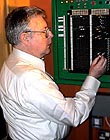|
|
This topic comprises 2 pages: 1 2
|
|
Author
|
Topic: 16mm Projectors - which one should I buy?
|
|
|
Evans A Criswell
Phenomenal Film Handler

Posts: 1579
From: Huntsville, AL, USA
Registered: Mar 2000
|
 posted 01-14-2002 02:04 PM
posted 01-14-2002 02:04 PM





I'm assuming that the school will have some old Bell and Howell 16mm machines. When I took care of the projectors for my junior high school in the 1980-1982 time period, we has several "autoload" models and one "slot load" model. The "slot load" type was much less problematic and much less likely to jam and damage film. If an "autoload" machine has not been well-maintained, I'd not recommend putting a treasured print through it. We had one jam that damaged a print in the "slot load" machine in a period of two years. We had jams in the autoload type every two or three weeks.By "autoload", I mean a machine where you push a lever, turn it on, feed the film in the front and it gets pulled through, hopefully emerging from the rear of the machine. By "slot load", I mean a machine where you push a lever down, manually load the film through a slot (very easy), then pull the lever back, and it's ready to go. The autoload mechanism misthreaded way too often, while the slot load typically eliminated misthreading, and if misthreaded, the slot load projector would not typically turn on until the problem was corrected. I should say that I have not seen or touched either type of machine since spring 1985. ------------------
Evans A Criswell
Huntsville-Decatur Movie Theatre Information Site
| IP: Logged
|
|
Scott Norwood
Film God

Posts: 8146
From: Boston, MA. USA (1774.21 miles northeast of Dallas)
Registered: Jun 99
|
 posted 01-14-2002 02:06 PM
posted 01-14-2002 02:06 PM





Look for the newer models--you should be able to get nice slot-load Eikis or Elmos for under $75-100 each. The older manual-load B&H (100 and 300 series) and RCA models are good, too. Some people like the Kodak Pageants (I don't). Keep an eye out for anything "big" (xenon, carbon-arc, MARC-300, etc.) or any scope lenses; even if you don't want this stuff, you should be able to sell it on Ebay or in Big Reel and make a decent profit if you can get it at fire-sale prices.Don't waste time with the auto-load B&H models or anything that looks like it has been abused. There's so much good equipment out there available so cheaply that it isn't worth risking good prints to junk machines. Be sure to get rewind bench stuff (splicers [both tape and cement], rewinds, sync block, etc.) if possible. In addition to the usual sources for used prints, you can buy lab-new prints of some classic films in the public domain (mostly silents) from Blackhawk distributors (e.g. Festival Films, etc.). They aren't cheap, but the quality is usually pretty good.
| IP: Logged
|
|
|
|
|
|
|
|
Ken Layton
Phenomenal Film Handler

Posts: 1452
From: Olympia, Wash. USA
Registered: Sep 1999
|
 posted 01-14-2002 06:18 PM
posted 01-14-2002 06:18 PM




Hey, now wait a minute! I'm a factory trained Bell & Howell man. I feel they are some of the finest machines made. For info, here is the real good B&H models:manual threading: 179, 185, 285, 399, 535, 540, 614 JAN, 1540, 1579
Autoload: 552, 1552, 1595, 2595
Slotload: don't buy, nothing but trouble
Arc lamp models: 140 (carbon arc), 566 (Marc-300), 567 (Marc-350), xenon JAN, and 1568 (Gemini-300) On any of the B&H machines in the 1500 or 2500 series, turn on the motor and listen or feel for heavy vibrations. That's an indication of a "Cracked" worm gear which is an expensive and time consuming repair. If you spot any Eiki machines, look for any with an "EX-" as part of the model number. That indicates a Xenon Lamp model.
| IP: Logged
|
|
|
|
|
|
Jon Miller
Jedi Master Film Handler

Posts: 973
From: San Diego, CA, USA
Registered: Sep 1999
|
 posted 01-14-2002 10:43 PM
posted 01-14-2002 10:43 PM




I'd put my vote in for the Kalart-Victor 70-, 75-, 80-, or 82-series projectors, smooth-running machines with unique "safety film trips" which stop the mechanism if a loop goes south to prevent further sprcket hole damage. (The 70-15 model is by far the most common of the line). Threading the Kalart-Victor is kind of an acquired taste, though, with its inside-out film path. These machines are not terribly difficult to service, if you can find parts.Kodak Pageants and Eikis are still worthwhile; an EX-series xenon Eiki would be quite a find. Manual-threading Bell and Howells are OK, too, as are the 3585s on up (rebadged Eiki SNT/ENT units). But, as mentioned earlier, stay away from Hell and Bowell Autoloads (545-552, 1545-1552, 1585-1592, and 2585-2592)!
| IP: Logged
|
|
|
|
|
|
|
|
|
|
|
|
|
|
All times are Central (GMT -6:00)
|
This topic comprises 2 pages: 1 2
|
Powered by Infopop Corporation
UBB.classicTM
6.3.1.2
The Film-Tech Forums are designed for various members related to the cinema industry to express their opinions, viewpoints and testimonials on various products, services and events based upon speculation, personal knowledge and factual information through use, therefore all views represented here allow no liability upon the publishers of this web site and the owners of said views assume no liability for any ill will resulting from these postings. The posts made here are for educational as well as entertainment purposes and as such anyone viewing this portion of the website must accept these views as statements of the author of that opinion
and agrees to release the authors from any and all liability.
|

 Home
Home
 Products
Products
 Store
Store
 Forum
Forum
 Warehouse
Warehouse
 Contact Us
Contact Us




 Printer-friendly view of this topic
Printer-friendly view of this topic
















 .
.



